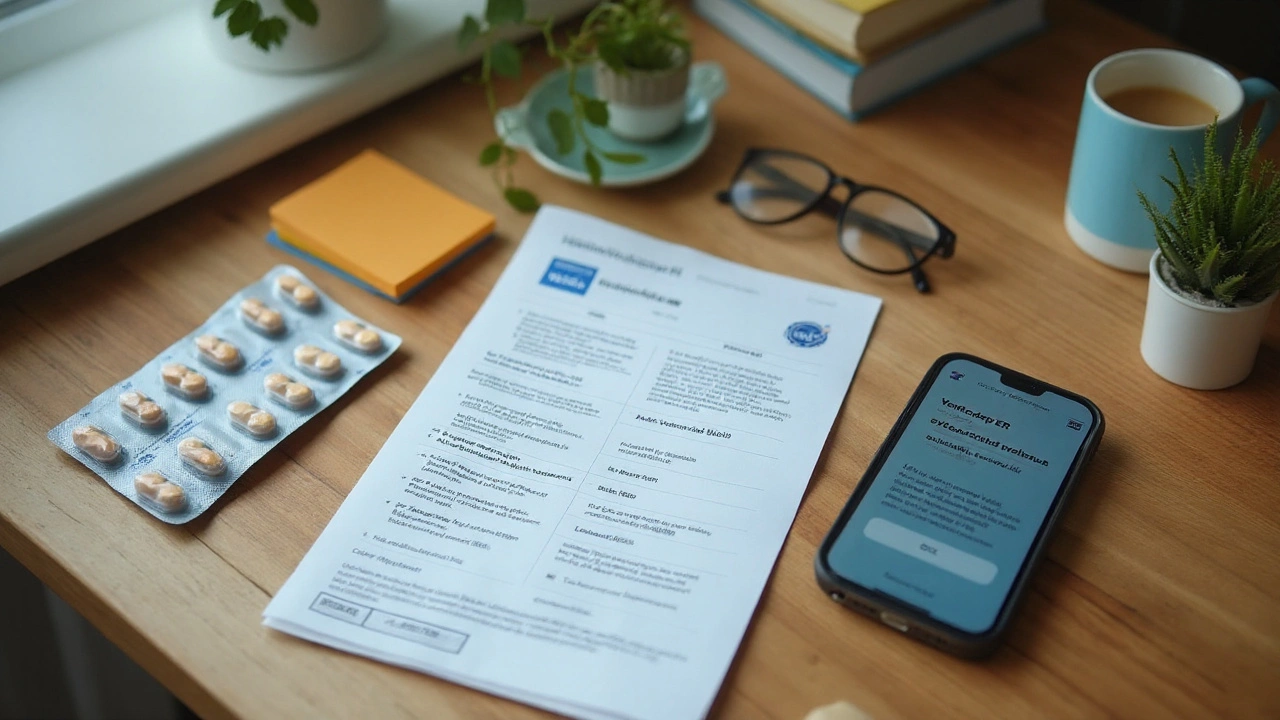You searched the brand name, got a wall of conflicting answers, and now you just want the exact facts. Here’s the deal: brand names can vary by country, and what matters most is the active ingredient. This guide shows you the fastest way to find the official prescribing info for Ventodep ER, what it likely is used for, how extended-release antidepressants are usually taken, and the safety checks you shouldn’t skip. I’ll keep it plain, UK-focused, and practical. Expect clear steps, decision rules for real-life moments (missed doses, side effects), and credible sources like MHRA, NHS, NICE, and the product’s Patient Information Leaflet (PIL) or Summary of Product Characteristics (SmPC).
Find the Official Ventodep ER Info Fast (UK-first, works globally)
Job to be done: You want the exact, up-to-date leaflet or label-no guesswork. Here’s the shortest path.
- Check the box or blister: Look for “Active ingredient” and the strength (e.g., 37.5 mg, 75 mg, 150 mg). Note the manufacturer’s name and “ER/XR/XL” marking if present.
- UK route (best if you’re in England, Scotland, Wales, Northern Ireland):
- Go to the electronic Medicines Compendium (emc). In the search bar, type “Ventodep ER” exactly. If no result, search the active ingredient you saw on the pack.
- Open the SmPC (for clinicians) and PIL (for patients). These are the official, regulator-approved documents (MHRA basis in the UK).
- If “Ventodep ER” isn’t listed:
- Search by likely actives used in ER antidepressants: venlafaxine extended-release or desvenlafaxine prolonged-release.
- Match the strength to your pack. Cross-check the dosing instructions-ER products are usually once daily and must not be crushed.
- Outside the UK or brand not on emc:
- Use your country’s regulator: EMA (EU), FDA DailyMed (US), Health Canada Drug Product Database, TGA eBS (Australia), or your national agency.
- Search the brand name first. If not found, search the active ingredient plus “extended-release” or “prolonged-release.”
- Ask a pharmacist (fastest human option): Bring the pack. Ask: “What’s the active ingredient and the official leaflet?” Pharmacists can print or text you the PIL within minutes.
Why the fuss about labels? Because the brand “Ventodep ER” might be a regional name for a familiar medicine. Extended-release antidepressants commonly use venlafaxine ER or desvenlafaxine PR. NICE and NHS guidance often place venlafaxine as a second-line antidepressant if SSRIs didn’t work well, or for certain anxiety disorders-so you’ll see it a lot in UK practice. But don’t assume. Verify the active ingredient first.
Quick visual cues when you find the right page:
- Look for “SmPC” and “PIL” headings.
- Confirm dosage forms and strengths match your pack.
- Check the “last updated” date (you want the latest version, especially in 2024-2025 as labeling often updates).
Manchester note: in England, you usually pay the standard NHS prescription charge per item unless exempt. If you’re on regular meds, a Prescription Prepayment Certificate can cut costs.

Safe Use: Dosing, Side Effects, Interactions, and Real-World Rules
Job to be done: Use Ventodep ER safely and get the best chance of benefit with the least hassle. I’ll cover dosing logic, what you might feel in week 1 versus week 6, and the red flags that need action.
First principles for extended-release antidepressants (like venlafaxine ER / desvenlafaxine PR):
- Once daily, same time, with food if the leaflet suggests it-it often reduces stomach upset.
- Do not cut, crush, or chew. ER tablets/capsules rely on slow-release technology. Crushing can dump the dose at once.
- Onboarding is gradual. Mood benefits may take 2-6 weeks. Early side effects (nausea, jittery feeling, headache) often ease after 1-2 weeks.
- Stopping suddenly can trigger discontinuation symptoms (dizziness, “brain zaps,” irritability, flu-like feelings). Always taper with your prescriber.
If Ventodep ER contains venlafaxine ER (common in many “ER” antidepressant brands), here’s the typical UK-style framework you’ll see on SmPC/PIL and in NHS practice:
- Indications often include: major depressive disorder; generalised anxiety disorder; social anxiety disorder; panic disorder.
- Dosing pattern (typical ranges; your prescriber will adjust):
- Start: 37.5-75 mg once daily.
- Usual effective: 75-150 mg once daily.
- Higher for some: up to 225 mg/day (sometimes 300 mg under specialist care).
- Blood pressure: venlafaxine can raise BP, especially at higher doses. UK SmPCs recommend baseline and periodic checks.
- Sleep: can cause either drowsiness or insomnia. Morning dosing helps if you get insomnia; evening dosing helps if it makes you sleepy.
- Sexual side effects: reduced libido, delayed orgasm-talk to your clinician; dose tweaks or alternative agents can help.
- Discontinuation: taper slowly over weeks. Your GP will set a schedule.
If Ventodep ER is desvenlafaxine PR, the themes are similar-once daily, do not crush, watch for nausea and BP changes-with differences in dosing (often 50-100 mg/day) and labeling details. Again, confirm via the leaflet you found.
Common side effects you might see listed on UK SmPCs for venlafaxine ER (ballpark frequencies): nausea, dry mouth, sweating, insomnia or drowsiness, dizziness, headache, constipation, reduced appetite, sexual dysfunction. Most are mild to moderate and improve. Serious but less common risks can include significant blood pressure rise, serotonin syndrome (especially if combined with other serotonergic meds), hyponatraemia (low sodium, more in older adults), angle-closure glaucoma in predisposed individuals, and mood switching if bipolar disorder is undiagnosed.
Important interactions and do-not-combine rules (always check your exact PIL/SmPC):
- Do not take with MAOIs, or within the washout period (usually 14 days, but check your leaflet). This is a hard stop to avoid serotonin syndrome.
- Use caution with other serotonergic meds: SSRIs/SNRIs, linezolid, triptans, tramadol, lithium, St John’s wort. Watch for restlessness, sweating, tremor, confusion, fever.
- Bleeding risk rises with NSAIDs, aspirin, or anticoagulants-report unusual bruising or bleeding.
- Alcohol can worsen drowsiness and judgment-keep it low, especially at the start.
Pregnancy and breastfeeding: UK guidance usually recommends a personalised risk-benefit discussion. For some patients, staying on treatment is safer than stopping. Your GP or perinatal mental health team will advise. Do not stop suddenly if you find out you’re pregnant-book a review and bring your leaflet.
What to do when real life happens:
- Missed dose (extended-release): If you remember within a few hours, take it. If it’s close to the next dose, skip the missed one. Never double up.
- Bad nausea in week 1: Take with food; sip water through the day; ask about taking it at night if it makes you woozy. Usually settles in 3-7 days.
- Early anxiety “activation”: It can happen-short-term support like sleep hygiene, temporary dose hold, or adjuncts may help. Speak to your prescriber.
- Rising blood pressure or pounding headaches: Check your BP. If high, call your GP or 111 for advice the same day.
- Stopping because you feel better: Please don’t do it alone. Relapse risk is real. Agree a taper plan.
| Feature | Extended-Release (ER/PR/XR) | Immediate-Release (IR) | Why it matters |
|---|---|---|---|
| Dosing frequency | Once daily | 2-3 times daily | Once-daily improves adherence; fewer peaks and troughs |
| Peak effects | Smoother | Sharper peaks | Smoother profile may reduce side effect spikes |
| GI tolerance | Often better | Variable | Taking with food helps both |
| If crushed/chewed | Unsafe (dose dump) | Usually OK | Never crush ER-check PIL for alternatives if swallowing is hard |
| Common side effects | Nausea, sweating, insomnia/drowsiness, dizziness, dry mouth | Similar list | Expect early effects to ease within 1-2 weeks |
| Withdrawal risk | Present-taper slowly | Present-taper slowly | Plan a taper with your prescriber |
Red flags that need urgent care (go to A&E or call emergency services): chest pain, severe headache with confusion, fainting, seizures, severe agitation, very high fever, stiff muscles, or thoughts of harming yourself. If you’re unsure, NHS 111 can triage you.

Scenarios, Checklists, and Quick Answers People Actually Need
Job to be done: Cut through the noise and handle the common situations without panic. Here are simple checklists and a compact FAQ.
Pre-start checklist (take to your GP or pharmacist):
- My current meds and supplements (including over-the-counter and herbal).
- Any past reactions to antidepressants, especially venlafaxine or desvenlafaxine.
- Blood pressure history and recent readings.
- Glaucoma, kidney, or liver issues; history of low sodium.
- Pregnancy plans or breastfeeding status.
- Alcohol use and sleep patterns.
Week 1-2 survival tips:
- Take it at the same time daily; set a phone reminder.
- Have a simple routine: light snack, tablet, short walk-movement helps nausea.
- Track symptoms in one line per day: mood (0-10), sleep hours, side effects.
- Avoid new supplements without asking-many “natural” products are serotonergic.
When to book a review:
- No improvement by week 4-6 or side effects still intrusive by week 3.
- Blood pressure rises or persistent headaches.
- Any suicidal thoughts-seek help immediately; don’t wait for a routine review.
- Sexual side effects that matter to you. There are options.
How to spot serotonin syndrome early (especially if combining serotonergic meds):
- Agitation or restlessness out of proportion
- Sweating, shivering, tremor
- Diarrhoea, fever
- Confusion, muscle twitching
If suspected, stop new dose and get medical advice urgently.
Mini-FAQ
- What exactly is Ventodep ER? - A brand name for an extended-release antidepressant. To know which active ingredient it contains (venlafaxine ER, desvenlafaxine PR, or another), check the pack or the official leaflet via emc or your national regulator.
- Is it for depression or anxiety? - Many ER antidepressant brands are licensed for major depression and some anxiety disorders. Confirm indications in the PIL/SmPC matching your pack.
- How long until I feel better? - Sleep and appetite may improve in 1-2 weeks; mood and energy often take 2-6 weeks. If nothing by week 6, ask for a review.
- Can I drink alcohol? - Best kept low. Alcohol can worsen sedation and mood swings, especially early on.
- What if I can’t swallow the capsule/tablet? - Do not crush ER forms. Ask the pharmacist about licensed alternatives (different strengths, liquid forms for other agents) or a switch. Your prescriber can help.
- Is it addictive? - Antidepressants aren’t addictive in the classic sense, but stopping suddenly can cause withdrawal-like symptoms. Taper gradually.
- Can it raise blood pressure? - Yes, venlafaxine especially at higher doses. Check BP periodically.
- Is it safe in pregnancy? - Needs a personalised decision. Don’t stop on your own-book an urgent review.
How to compare brands or generics quickly (practical steps):
- Match the active ingredient and the release type (ER/PR/XR).
- Match the strength (e.g., 75 mg ER in brand A vs 75 mg ER in generic B).
- Check capsule vs tablet and swallow instructions.
- Scan the SmPC for excipients if you have allergies (e.g., lactose).
- Ask your pharmacist about any switch-sometimes the shape or filler changes how it feels for you.
Evidence and sources I trust for this topic:
- MHRA-approved SmPC and PIL (via emc in the UK)
- NHS clinical pages on antidepressants and venlafaxine
- NICE guidance on depression and anxiety disorders (treatment sequencing, second-line choices)
Quick decision trees
- If you’ve just been prescribed Ventodep ER and feel worse in the first week → Check your leaflet for expected early effects → Keep dose time consistent → If severe anxiety, insomnia, or high BP, call your GP or 111 → Don’t stop abruptly unless told.
- If you missed yesterday’s dose and feel dizzy today → Take today’s dose at the usual time → Do not double → Hydrate → If symptoms are bad, call your pharmacist-ask if a temporary dose adjustment is sensible.
- If you want to stop because you feel better → Book a taper plan → Expect a weeks-long reduction → Monitor for withdrawal symptoms (dizziness, zaps) and mood drop.
Cost and access in the UK (2025):
- On NHS prescriptions, you’ll pay the standard charge per item unless exempt.
- Private scripts vary by pharmacy; generics are usually less costly than branded ER versions.
- If cost is a barrier, ask your GP about alternatives at the same effectiveness level or different strengths that can be split across packs to save.
Why some people feel “off” when swapping brands: Even when the active ingredient is the same, release mechanisms and excipients can differ. Most people do fine, but if you notice consistent issues after a switch, ask to go back to the version that worked or try another equivalent.
How to report side effects: In the UK, use the MHRA Yellow Card scheme. This helps improve safety information on future updates of the leaflet you’ll read.
Bottom line: Verify the active ingredient and the official leaflet first. Take extended-release meds once daily, don’t crush, taper slowly, and keep an eye on blood pressure. Use your GP and pharmacist-they do this every day, and a quick call saves weeks of guesswork.
Next steps:
- Find the exact Ventodep ER PIL/SmPC via emc (UK) or your national regulator using the steps above.
- Set a daily reminder and stick to one dosing time.
- Log your first 2-4 weeks: side effects, mood, sleep, BP if you can.
- Book a review at week 4-6 or sooner if you hit any red flags.
Troubleshooting by persona:
- Busy parent: Keep the blister by your toothbrush; dose right after brushing. If nausea hits, nibble a cracker first.
- Shift worker: Tie dosing to a meal you never skip (e.g., breakfast after waking) rather than clock time.
- Student: Don’t stack it with all-nighters and energy drinks. Hydrate, and keep caffeine moderate.
- Older adult: Ask for baseline sodium and periodic checks; bring a full med list to avoid interactions.
If you take just one thing from this: confirm the active ingredient on the official leaflet, then follow the ER rules-once daily, no crushing, slow changes, and keep your clinician in the loop.







